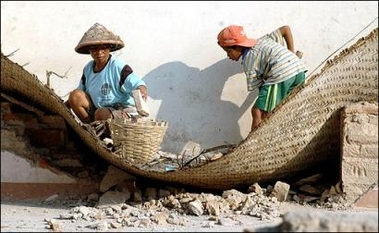Hundreds of children across parts of central Indonesia devastated by last
week's earthquake returned to damaged schools Monday to take exams under tents,
as local and international aid groups stepped up relief efforts.

A woman and a child
remove rubble from a house in Klaten. The United Nations has warned that
tens of thousands of Indonesia quake survivors still desperately needed
shelter as new aftershocks frightened jittery
residents.[AFP] |
The 6.3-magnitude earthquake struck central Java island on May 27, killing at
least 6,234 people and injuring some 30,000.
Adding to fears in the quake zone, activity at nearby Mount Merapi volcano
has increased since the temblor, triggering fresh alerts from the government
that a major eruption may be due.
The quake damaged or destroyed more than 130,000 homes and at least 835
schools, the U.N. children's agency and government officials said.
But on Monday, at least 10 schools held end-of-year exams for 8th grade
students in tents close to their former schools, the agency said.
"The pupils are not as cheerful as they used to be," said Nuroh Hidayutun,
the head teacher at one the schools in Serut, as 15 pupils puzzled over math
problems in a gloomy tent.
"But keeping up the routine is important," she said.
Across the road, student volunteers sang songs with around 35 kindergarten
students and gave them drawing lessons.
"There is nothing left of our house, so this entertainment is invaluable,"
said mother Aminiah, who had come to pick up her two children.
Many of the estimated 647,000 people displaced by the disaster are living in
makeshift shelters _ often just plastic tarps _ with no toilets or running
water, surviving of donated food.
Aid agencies stepped up supplies of clean water and latrines, but warn the
unsanitary conditions could lead to a wave of diarrhea and skin diseases, as
well as infecting cuts and breaks sustained in the quake.
The U.N.-affiliated International Organization for Migration, which has a
fleet of more than 100 cars and trucks at its disposal, transported scores of
patients home from local hospitals and trucked rice across the region.
The epicenter of the powerful quake was about 80 kilometers (50 miles) south
of the rumbling Merapi, one of the world's most active volcanos, and its
activity has increased since then.
Merapi's lava dome has swelled since the quake to 100 meters (330 feet),
raising fears that it could collapse, officials said. That could send
searing-hot clouds of gas and debris pouring down the slopes into inhabited
areas, the government volcanology center warned.
Indonesia is prone to seismic upheaval because of its location on the
so-called Pacific "Ring of Fire," an arc of volcanoes and fault lines encircling
the Pacific Basin.